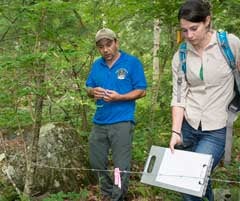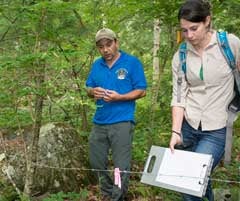 KINGSTON, R.I. – August 14, 2014 – Biologists from the University of Rhode Island and the Rhode Island Department of Environmental Management have begun a research program aimed at determining the population and movement patterns of black bears living in the state.
KINGSTON, R.I. – August 14, 2014 – Biologists from the University of Rhode Island and the Rhode Island Department of Environmental Management have begun a research program aimed at determining the population and movement patterns of black bears living in the state.
“We previously thought that all of the bears in Rhode Island were young males that had been displaced from their mothers’ territory in Connecticut and Massachusetts,” said URI Professor Thomas Husband, who is leading the project with DEM biologist Charles Brown. “But in recent years we’ve had reports of moms with cubs, which suggests that we may have breeding animals in the state.”
The scientists, including URI research associate Amy Gottfried Mayer, are setting up 42 “bear detectors” throughout western Rhode Island to collect bear fur that can be analyzed for its DNA. The detectors consist of barbed wire stapled from tree to tree in a circle with a scented lure in the middle. When the bears rub against the barbed wire on their way to the lure, they leave behind fur that will help to identify individual bears.
“Knowing individuals will tell us something about movement patterns and give us some idea of abundance,” Husband said. “Eventually we may be able to determine which bears are related to others and figure out their gene flow, where the corridors are they travel along, what the barriers are to their dispersal, and better understand their ecology as they repopulate the state.”
Black bears live in a broad range of habitats, but they are usually found near forests. Adult males grow fro 150 to 450 pounds, while females weigh up to 250 pounds. Although there is no historic data about the bear population in Rhode Island, it is believed they were wiped out during colonial days, along with mountain lions, wild turkeys and wolves. Bear populations in neighboring states are estimated to have been increasing by 7 to 8 percent annually in recent years, which may account for their range expansion into Rhode Island.
According to Husband, black bears have not yet become a significant problem in Rhode Island, although there have been instances of the animals damaging bird feeders and bee hives, entering chicken coops and killing livestock.
“Bears are very adaptable and intelligent and have proven they can survive living in close proximity to humans,” said Brown. “The challenge for wildlife managers in coming years is going to be finding the right balance between the number of bears that the habitat we have available can support, and the number of bears that people are willing to tolerate.”
“We are hopeful that we can understand these animals and their patterns as they move into our increasingly urbanized environment and reduce the amount of human/wildlife conflict that arises,” added Husband. “Just like we’ve done with coyotes and fishers, we’re all going to have to learn to live with these animals eventually.”
This month the biologists are constructing the bear detectors, after which the sites will be checked every week until winter, when the bears hibernate. Bright orange signs and reflective tape on the barbed wire will alert people to avoid the sites.
Husband hopes to acquire GPS collars to put on bears in the future to collect more detailed information about their movements. Later this year, he and Brown also plan to initiate a similar study of bobcats, another mammalian predator whose numbers and habits in Rhode Island are poorly known.
Pictured above: RIDEM wildlife biologist Charles Brown and URI research associate Amy Gottfried Mayer check for fur on a “bear detector” in South Kingstown.
Photo by Nora Lewis

